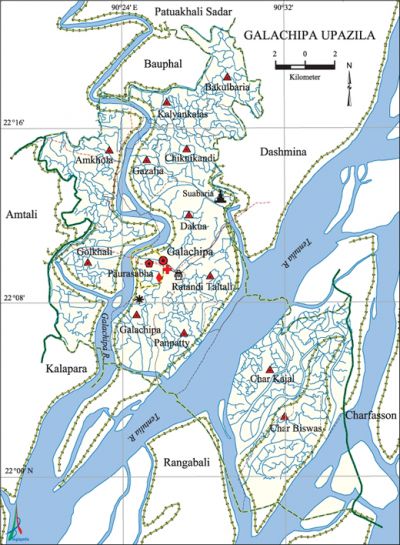Galachipa Upazila
Galachipa Upazila (patuakhali district) area 1267.89 sq km, located in between 21°48' and 22°21' north latitudes and in between 90°15' and 90°37' east longitudes. It is bounded by patuakhali sadar, bauphal and dashmina upazilas on the north, bay of bengal and rangabali upazila on the south, Dashmina and char fasson upazilas on the east,' amtali and kalapara upazilas on the west.
Population Total 238681; male 119189, female 119492; Muslim 217588, Hindu 21050, Buddhist 11 and others 32. Indigenous community such as rakhain belongs to this upazila.
Water bodies Main rivers: tentulia, Galachipa;' Rabnabad Channel is notable.
Administration Galachipa Thana was formed in 1873 and it was turned into an upazila in 1983.
| Upazila | ||||||||
| Municipality | Union | Mouza | Village | Population | Density (per sq km) | Literacy rate (%) | ||
| Urban | Rural | Urban | Rural | |||||
|
1 |
11 |
90 |
149 |
22301 |
216380 |
188 |
62.7 |
42.97 |
| Municipality | ||||||||
|
Area (sq km) |
Ward |
Mahalla |
Population |
Density (per sq km) |
Literacy rate (%) | |||
|
3.39 |
9 |
9 |
17373 |
5110 |
48.15 | |||
| Upazila Town | ||||||||
|
Area (sq km) |
Mouza |
Population |
Density (per sq km) |
Literacy rate (%) | ||||
|
5.13 |
2 |
4928 |
109 |
48.15 | ||||
| Union | ||||
| Name of union and GO code | Area (acre) | Population | Literacy rate (%) | |
| Male | Female | |||
|
Amkhola 11 |
11673 |
14159 |
13973 |
38.78 |
|
Gazalia 69 |
- |
2542 |
6815 |
45.98 |
|
Galachipa 67 |
11433 |
8098 |
7764 |
42.08 |
|
Golkhali 72 |
16730 |
14882 |
14844 |
38.17 |
|
Char Kajal 39 |
25159 |
11143 |
10214 |
28.82 |
|
Char Biswas 37 |
- |
8892 |
8215 |
36.84 |
|
Chiknikandi 50 |
12188 |
7484 |
7522 |
50.52 |
|
Dakua 55 |
8017 |
9174 |
8699 |
46.72 |
|
Panpatty 78 |
7185 |
8781 |
8456 |
55.08 |
|
Bakulbaria 22 |
12792 |
13748 |
14079 |
43.58 |
|
Ratandi Taltali 94 |
7396 |
8455 |
8441 |
46.13 |
Source Bangladesh Population Census 2001, Bangladesh Bureau of Statistics.
Archaeological heritage and relics Sutabaria Dayamayee Mandir (1208), Single Domed Gurinda Mosque at Ratandi (18th century).
Historical events The Pak army raided the villages Chikanikandi and Dakua on 8 May 1971, killed 29 villagers and sacked many houses. On 18 november, three members of the Pak army were killed in a skirmish between the Pak army and the freedom fighters at village Panpatti.

Marks of the War of Liberation Memorial monument 2.
Religious institutions Mosque 1001, temple 50, buddist temple 10, pagoda 1, tomb 3. Noted religious institutions: Single Domed Gurinda Mosque at Ratandi (18th century), Talukdar Bari Mosque at Bashbaria (20th century), Lamna Shikdar Bari Mosque, Sutabaria Dayamayee Mandir (1208), Kacharibari Mandir, Kalyankalas Kalibari Mandir.
Literacy rate and educational institutions Average literacy 52.84%; male 46.5%, female 39.1%. Educational institutions: college 7, secondary school 53, primary school 230, satellite school 14, community school 9, madrasa 8. Noted educational institutions: Galachipa Degree College (1972), Galachipa Mahila College (1995), Patbunia Adarsha Technical College (1996), Ulania Hat School and College (1995), SM Sikandar Ali Chowdhury Degree College (1994), Chiknikandi Secondary School (1930), Galachipa Secondary School (1932), Patbunia Secondary School (1967), Kharijjama Secondary School (1966), Lamna Salehia Senior Fazil Madrasa (1935).
Cultural organisations Library 1, club 22, press club 1, theatre group 2, jatra party 1, cinema hall 6, playground 52.
Tourist spots Sunrise and sunset can enjoyed from Sonar Char of this upazila. Kalaraja, the capital of the queen Kamala of Chandradwip and Rabnabad Channel and Rangabali Channel are also notable.
Main sources of income Agriculture 68.18%, non-agricultural labourer 5.41%, industry 0.40%, commerce 11.53%, transport and communication 1.19%, service 4.22%, construction 1.23%, religious service 0.25%, rent and remittance 0.18% and others 7.41%.
Main crops Paddy, pulse, betel nut, peanut, chilli, vegetables.
Extinct or nearly extinct crops Sesame, mustard, kaun, boro paddy, sakshar-kora paddy.
Main fruits Mango, jackfruit, papaya.
Fisheries, dairies and poultries This upazila has a number of fisheries, shrimps, dairies and poultries.
Communication facilities Pucca road 46 km, semi-pucca road 20 km, mud road 1000 km.
Extinct or nearly extinct traditional transport Palanquin, bullock cart.
Noted manufactories Rice mill, saw mill, ice factory, welding factory.
Cottage industries Weaving, goldsmith, blacksmith, tailoring, wood work.
Hats, bazars and fairs Hats and bazars are 51, fair 1, most noted of which are Galachipa Bazar, Kalagachhia Hat, Ulania Hat, Baherchar Hat, Sutabaria Dayamayee Mela.
Main exports Paddy, fish, peanut, chilli, betel but.
Access to electricity All the wards and unions of the upazila are under rural electrification net-work. However 5.19% (urban 41.05 and rural 2.49) of the dwelling households have access to electricity.
Sources of drinking water Tube-well 91.57%, pond 5.40%, tap 0.25%, and others 2.78%.
Sanitation 13.16% (rural 9.69% and urban 69.84%) of dwelling households of the upazila use sanitary latrines and 74.92% (rural 78.74% and urban 24.14%) of dwelling households use non-sanitary latrines; 11.92% of households do not have latrine facilities.
Health centres Upazila health complex 1, satellite clinic 4, non-government health centre 1, family planning centre 10.
Natural disasters The devastating cyclones of 1584, 1960 and 1970 and the flood of 1876 caused huge loss of life and damages to settlements, livestock and other properties of the upazila.
NGO activities asa, SCI, CODEC, brac, Urban, SAP-Bangladesh, BAOPA, CEP BARD, CHDP. [Sankar Lal Das]
References Bangladesh Population Census 2001, Bangladesh Bureau of Statistics; Cultural survey report of Galachipa Upazila 2007.
